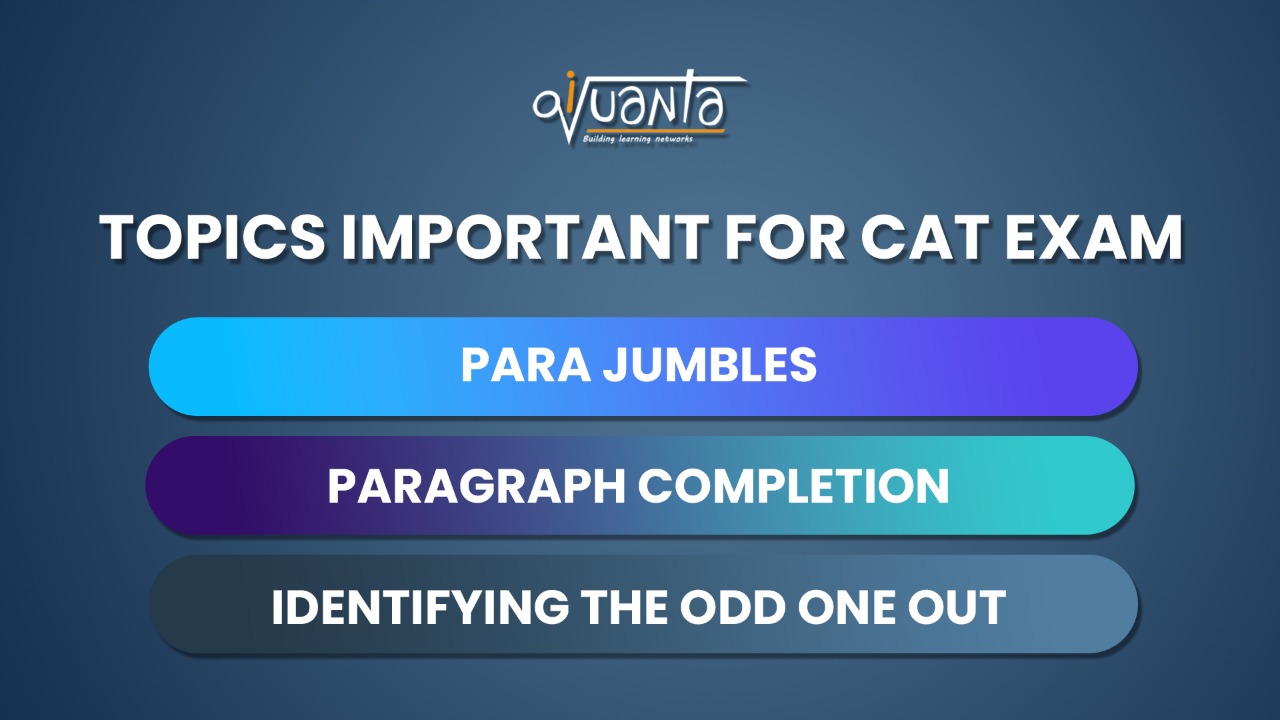VARC Strategy for CAT Exam

What is Verbal Ability?
Verbal ability refers to the ability in being able to express one’s thoughts using words clearly and understandably. Verbal ability forms part of many competitive examinations. In this ability, the students are mainly tested on their ability to form sentences correctly, are able to identify the odd one out, identify errors in a sentence, are able to write a cohesive summary of the passage provided, find a pattern in the jumbled words, and many more.
The questions mentioned above are just a few of the many ways to test the verbal ability of the candidates in various exams like the CAT test. Having a proper VARC strategy is thus essential for the CAT exam.
Verbal Ability Strategy for CAT
The syllabus of Verbal Ability for CAT includes (but not entirely) the following questions:
- Inferential Logical Reasoning
- Para Jumbles
- Summary
- Contextual Usage
- Idioms
- One word substitution
- Misfit/Out of Context sentence/Odd one out
- Paragraph Completion
The details for the syllabus in the Verbal ability in the VARC section for CAT has been described below:
To check the reading comprehension (RC) strategy for the CAT.
Inferential Logical Reasoning: such types of questions for the CAT exam require you to draw some inference from the passage. Now the trick is either the word ‘inference’ is explicitly mentioned in the question or it is subtly hinted that you are required to draw an inference. For example, in the questions below the word ‘inference’ is not mentioned but subtly hinted:
- Which of the following must be true based on the above statements?
- Which of the following is most strongly supported by the information?
So, the first step is to identify the nature of the question and know exactly what is being asked. You can do so by rephrasing the question in your own words. Next, you can eliminate the wrong answers by ruling out the unrelated possibility—although this might be tricky at first. But with a proper VARC strategy for CAT, you will be able to answer them relatively quickly.
Para-Jumbles: the para jumbles asked in the CAT exam are different from the other management exams in the sense that the questions asked in the CAT exam are of non-MCQ type. You are provided with a few sentences (usually 4), and you are required to arrange them logically.
Summary: The paragraph summary in the CAT exam carries 10 marks, which is almost 20% of the total. Therefore, it becomes crucial for aspirants to prepare this topic well. The questions will ask you to choose an option that would most appropriately capture the summary of the whole paragraph (that is of 100-150 words).
You can use the following VARC strategy for CAT to solve such questions:
- Know the structure: most of the reading passages follow a set structure. There is an introduction, a body and a conclusion. Look for sentences that change the passage’s topic. Mark them as important. Highlight the essence of each topic, what they are talking about.
- Identify keywords: each passage must have certain keywords around which the central idea of the RC might revolve. Mark such keywords and move ahead with your preparation. They will help you in answering the questions that will follow.
- Compare the options: check the logical differences in the options provided. Usually, the correct option will not contradict the essence of the paragraph. Choose the option that closely aligns with the message of the paragraph.
- Elimination: then slowly move on to eliminating the wrong options. If the two options share similar information, eliminate the option that adds the least value to the paragraph.
Contextual Usage: certain foreign words in English are borrowed from other languages. The understanding of contextual Usage of those words is the key to answering these questions. For example:
Pagoda:
A. A turban
B. A gold coin
C. A temple
D. A high ranking nobleman
Idioms: there are certain common idioms that you can remember for competitive exams like the CAT exam. They are often simple and can be easily remembered. For example, there are idioms like “a blessing in disguise”, “a Dime a Dozen”, “a drop in the bucket”, et cetera.
One-word Substitution: in these types of questions, you will be provided with a sentence that would be required to be substituted with one word. For example:
- “The one who does not believe in God”, this sentence can be substituted by the word “atheist”.
- Similarly, “the one who eats flesh” can be substituted by the word “cannibal”.
Sentence Completion: as the name suggests, you will be required to complete an incomplete sentence. There would be a list of four options, and you will be required to choose the most appropriate choice that will complete the sentences mentioned in the question. Refer to the example question below to test your varc strategy:
The underlying reason for the uncontrolled inflation in the household’s key consumables is the government’s failure to do its job. Private players offer services at usurious costs to meet the demands of a growing middle class
- Who wish to pass their life peacefully without getting engaged in many aspirations.
- That is reeling under the pressure of rising prices but anyhow trying to make both ends meet
- Which aspires to move up the ladder and secure a higher level of income.
- Which is left with no alternative but to manage by reducing its expenses on essential commodities
- A 2. B 3. C 4. D
Odd One Out: the question is very similar to para jumbles, but instead of arranging the given options in a logical order, you are required to identify the odd one out that makes the least logical sense. You will be provided with a list of 5 choices.
For example:
Five sentences related to a topic are given below. Four of them can be put together to form a meaningful and coherent short paragraph. Identify the odd one out.
- People who study children’s language spend a lot of time watching how babies react to the speech they hear around them.
- They make films of adults and babies interacting and examine them very carefully to see whether the babies show any signs of understanding what the adults say.
- They believe that babies begin to react to language from the very moment they are born.
- Sometimes, the signs are very subtle — slight movements of the baby’s eyes, head, or hands.
- You’d never notice them if you were just sitting with the child, but by watching a recording over and over, you can spot them.
These are some of the important types of questions that can be included in your VARC strategy for CAT. However, recently, questions from this section are mainly concentrated on just three types of questions: para jumbles, paragraph completion and identifying the odd one out.

Also, make sure that you practice as many previous year papers for the verbal section as you can. It mainly consists of topics like Para-jumbles, Para-summaries, Odd One Out, etc. After you’ve gained at least 80-90% accuracy with the questions and RCs, start appearing for mocks and analyse them so that you can figure out and work out your weaknesses.
Try to enrich your vocabulary by memorising at least a few words daily. You can also watch literary movies with subtitles on to make preparation fun.
These were the important VARC strategy for CAT you needed to focus upon to ace the section. For the detailed CAT 2023 preparation strategy, follow the link:
To enrol in the CAT 2023 course, visit the link in the banner below:
To get FREE counselling, guidance and 24*7 doubts solving, visit the iQuanta’s CAT Preparation Fb Group:


